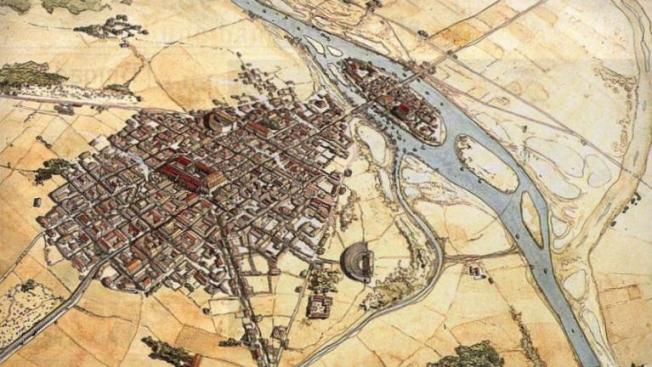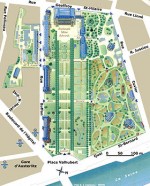Hormis le Stade de France principalement dédié au football ou au rugby, savez-vous quel est, aujourd’hui, le plus grand lieu « théâtral » à Paris ? Le Palais des Congrès ? Le Zénith ? Que nenni ! Vous n’y êtes point.
Souvent aveuglés de modernité, nous croyons que le plus « grand » est dans le présent ou le futur. C’est avoir piètre opinion du passé car, figurez-vous, que le plus grand théâtre à Paris date de 1800 ans (voir photo, ci-contre) et peut accueillir 17 000 personnes. Ce sont les arènes de Lutèce situées dans le 5ème arrondissement. Rendons-nous compte ! Une agglomération d’environ 20 000 personnes qui s’offrait un lieu de distraction de 17 000 places. Ces gens avaient le sens du loisir !
Mais, revenons aux arènes. Elles font 132m de long et 100m de large. Il s’agit d’un complexe hybride, de type « amphithéâtre à scène » ou encore « amphithéâtre-théâtre », comportant à la fois une scène pour les représentations théâtrales et une arène pour les combats de gladiateurs et autres jeux de l’amphithéâtre. La scène de théâtre, d’une longueur de 41,20 m, est de taille considérable. Les combats d’hommes et d’animaux se déroulaient sur la piste centrale d’environ 2500 m2. Allez voir, cela vaut le détour. On peut voir l’emplacement de la loge des acteurs, la plateforme de la scène et des éléments lapidaires. Menacées de destruction à la fin du 19ème siècle pour y installer un dépôt de tramways, elles furent sauvées par le grand Victor Hugo qui se fâcha très fort auprès du Président du Conseil Municipal de Paris : Conservez les Arènes de Lutèce. Conservez-les à tout prix. Vous ferez une action utile, et, ce qui vaut mieux, vous donnerez un grand exemple. Je vous serre les mains. » . Le père Hugo étant un monument à lui seul, le Conseil n’osa le contrarier et, quelques jours après, se porta acquéreur des arènes. Aujourd’hui, il n’y a plus de spectacles théâtraux ni de combats de gladiateurs. Et c’est tant mieux pour ces derniers. Parfois, cependant, observant la cruauté croissante de certains programmes de télévision, notamment anglaise, japonaise ou sud américaine, je me demande si nous n’allons pas y revenir insidieusement, un jour ou l’autre. En attendant, les arènes de Lutèce servent, gratuitement, de terrain de jeu à de jeunes footballeurs en herbe ainsi qu’aux joueurs de pétanque. Elles accueillent, quelques fois par an, de petits festivals de quartier. Qui pourrait imaginer qu’en ces mêmes lieux, des hommes trépassèrent, régulièrement et pendant des siècles, déchiquetés par les fauves, au plus grand plaisir de nos glorieux ancêtres les Gaulois !
The Arena of Lutetia
Apart from the Stade de France, which is mainly devoted to football and rugby, do you know what the largest ‘theatrical’ venue in Paris is today? The Palais des Congrès? The Zénith? No, you’re not even close.
Often blinded by modernity, we think that the ‘biggest’ is in the present or the future. But that is underestimating the past because, believe it or not, the largest theatre in Paris is 1800 years old (see photo, opposite) and can welcome 17,000 people. It is the Arena of Lutetia situated in the 5th arrondissement. Imagine that! A city with a population of around 20,000 people that built itself a place of entertainment with 17,000 places. These people really valued their leisure time!
But let’s come back to the Arena. It is 132m long and 100m wide. It is a multi-purpose complex, a sort of ‘amphitheatre with a stage’ or an ‘amphitheatre-theatre’, made up of a stage for theatrical performances and an arena for gladiator combats and other amphitheatre sports. The stage itself is grandiose at 41.20 m long. The combats of men and animals took place on the central strip of around 2500 sq. m. Go and take a look, it is really worth the trip. You can see the location of the actors’ ‘dressing room’, the platform of the stage and stonework elements. Threatened with destruction at the end of the 19th century by a plan to create a tramway depot there, the site was saved by the great Victor Hugo who forcefully pleaded its case to the President of the Municipal Council of Paris: “Conserve the Arena of Lutetia. Conserve it at any cost. You will be doing something useful, and, even more importantly, you will be setting a great example. I shake your hand ». Given that Victor Hugo was a monument in himself, the Council did not dare go against him, and purchased the site a few days later. Today, there are no more theatrical shows or gladiator combats (very fortunately for the latter case!). Sometimes, however, when I see the increasingly cruelty of certain TV programmes, especially English, Japanese and South American, I wonder if we are not going to see them again one day. In the meantime, the Arena of Lutetia is a park (free admission) where budding footballers and petanque players meet. A few times a year it hosts small neighbourhood festivals. It is hard to imagine that, on this same spot, men died, regularly and for centuries, torn apart by wild animals to the amusement of our glorious ancestors the Gauls!
Arènes de Lutèce
Métro Jussieu
Horaires : été 9h-21H30 / hivers 8h-17h30
Lundi – mardi – mercredi –jeudi –vendredi- samedi -dimanche
Didier MOINEL DELALANDE








